Horse Body Language
(Part One)
Watch Both Ends
A horse communicates with her head and with her hindquarters. These are the speaking ends, and the dangerous ends. Watch both when you are on the ground working around your horse or when you are riding in a group of other horses. Here's a quick look at some of the key signals to be mindful of.
Ears Back
Your horse's ears are her most mobile and expressive feature. As a horseman you will learn to watch them instinctively to see what she is thinking. Most people believe that when a horse puts her ears back she is expressing anger or aggression. This is true only some of the time. Other times it may indicate
threat she's listening behind her, that she's afraid, or even that she is a little sleepy. When a horse puts her ears back flat to her neck and shows the white of her eyes, she really means it! You will often see horses in groups use this expression with one another. It is a threat, and the threat may be followed up with a bite or sometimes a kick. Be ready to get out of the way or to correct your horse sharply if she seems about to attack a friend's unsuspecting mount. Just between horses, this expression doesn't mean anything terrible about your horse's nature. If she pulls this face at you, though, watch out. It is an extreme expression, and you should react with caution. Most horses won't use this expression towards humans; I would strongly advise against buying a horse who does. Your horse can vary this threatening expression considerably. You'll see it flashed between horses as they pass each other or as one comes too close to another's pile of hay. You may receive a mild version of it yourself if you tighten the girth too rapidly. You'll learn to see the difference between a mildly threatening look and a serious threat. You won't jump out of your skin every time your horse pins back her ears. You will notice the signs of bad temper, though, and increase your watchfulness.
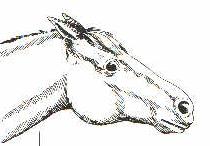
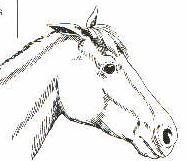
(left) An angry horse will frequently put her ears back and show the whites of her eyes. If you see this type of expression, be careful!
(right) An attentive horse will often tip one or both ears back to listen for your commands.
Not Always A Threat
When your horse's ears go back, it doesn't always mean she's angry or threatening. When you are riding or working around her, your horse will tip one or both ears back. This shows that she's paying attention to you. She's listening for your voice or footsteps. This is a good attitude, which increases your coordination together and your safety. If your horse is bored or half-asleep, her ears will tip back and out to the side at a gentle angle. You'll want to watch for the ears on a sleepy or bored horse to move before you approach, indicating that she's aware of your presence. In order to be fair to your horse and to understand what she's feeling, you must learn to recognize the differences among all these ways of putting back the ears. You don't want to scold her for aggression when she's only feeling bored, but you do want to be sure to keep her alert. By the same token, you don't want her to take you by surprise when she suddenly attacks a passing pony. With observation you'll be able to tell the difference easily, just as you can when a human is smiling or sneering.
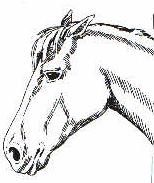
Ears tipped back and out are a sign of boredom.
Ears
Forward
People usually interpret ears pointed forward as an expression of friendliness and good cheer, a safe expression. Often this is true, but there are situations in which your horse's pricked ears are a definite danger signal. Your horse's ears will always point to where her interest lies; that grain pail in your hand, the horse across the road, the flying piece of newspaper, or the neighbor's yapping dachshund. when you are out riding on an interesting new trail, your horse will usually cruise along with her ears forward. She's taking in the sights and paying more attention to the scenery than to you. This is no problem if the footing is good and if you aren't
demanding a precision performance from her. If the footing is questionable, though, you'll want to regain a little of her attention. Stop and start once or twice, unexpectedly, and wake her up a little. Make sure you decide which side of a rock or tree you pass on. She should be aware that you are up there, in control of things. If your horse is straining her ears forward at a strange horse, she's probably intending to sniff noses with that horse. Loud squeals, kicks, or nips may follow - unsafe for horses and riders both. be aware of who your horse is pointing her ears at when you're riding in a group, and be prepared to prevent a squabble. Intensely pricked ears can also mean that your horse is likely shy. If some new object startles her she may stop, ears pricked and head high, and then leap sideways. These early-warning signs can pass very quickly. She may prick her ears and jump at the same moment. Still, pricked ears can often warn you in time - and a horse who pricks her ears at every leaf of burdock along the trail may be a horse who is looking for something to shy at. She needs to be watched and corrected - but not too harshly. It's usually just an expression of high spirits. Another time to watch pricked ears is when you're standing within nipping range. Pricked ears can express mischief, and mischief often means a quick, playful bite.
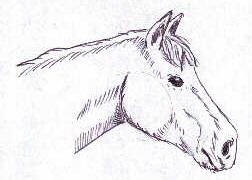
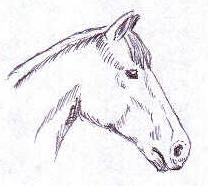
(left) Upright or forward ears generally indicate an alert horse.
(right) Stiff and tilted ears are a first sign of fear.
Facial Expressions
Horses have facial expressions that are subtle and hard to describe. You'll learn to know when the look in your horse's eye means she's feeling sullen or that she's expecting something pleasant. Narrowed eyes and a tight, pinched mouth often indicate a bad mood. They can also indicate pain - which comes down to the same thing, really. A horse in pain is often cross and dangerous. If you don't notice her problem and work her while she's sick, you could make whatever's wrong with her worse. But a pinched mouth and nostrils may mean nothing more than that she's bloating; that is, filling her belly with air and holding her breath while you tighten the girth. When she lets the air out the girth will be loose - nice and comfortable for her, dangerous for you. If your horse bloats, learn what her face looks like when she's doing it. If you spot the tell-tale signs of bloating on her face, fit the girth so that it's barley snug. Then tighten the girth in stages, pausing between each effort to give her time to exhale. You want to make sure that your girth is properly tightened before you mount.
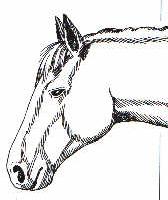
A pinched mouth and narrow eyes may be a sign your horse is in pain or a bad mood.
Part Two (cont.)
Gallop
back to The Horse Lover's Corral
© Copyright 1999,
2000, 2001, 2002, 2003
The Horse Lover's Corral